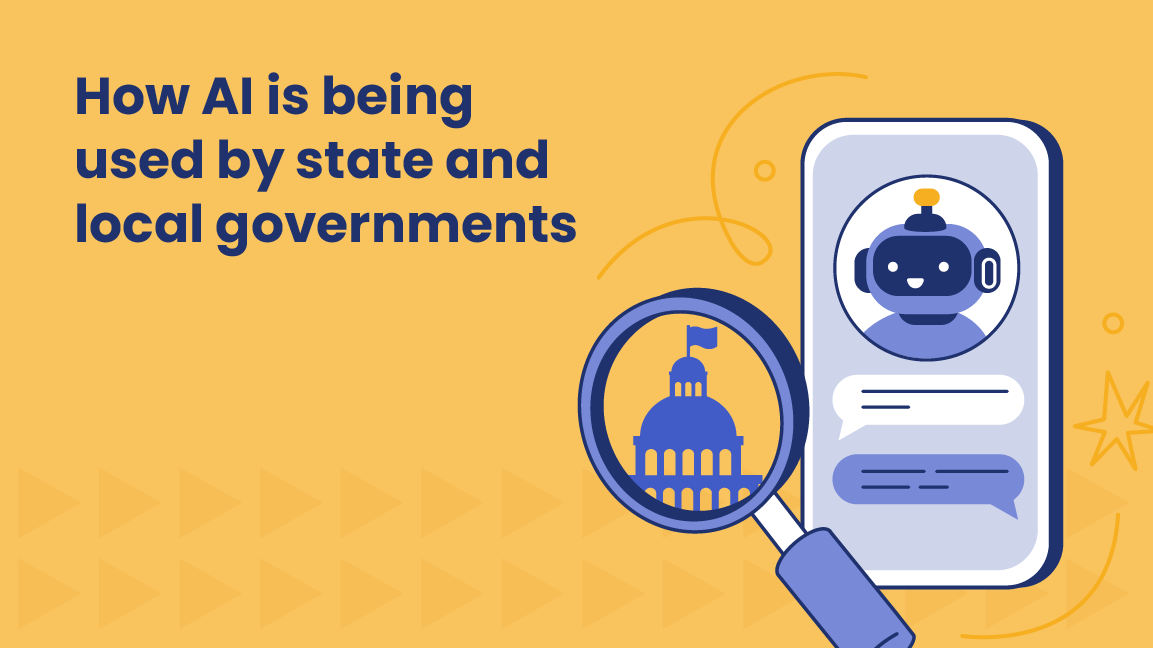How is AI being used in state and local governments right now?

State and local governments are increasingly leveraging artificial intelligence (AI) to enhance public services, improve efficiency, and ensure safety. Unsurprisingly, for 2025, NASCIO members vaulted AI to the number 2 spot for strategies and number 1 for priority applications, reflecting the technology’s potential to address numerous challenges that state and local governments face.
State and local governments have already implemented AI
AI is no longer a buzzword. It’s here, and AI is reshaping the way cities operate — everything from using AI in resident-facing systems to back-end automation can improve response times without losing the human touch. AI isn’t about replacing employees, but it is saving them time — and getting residents more specific information, faster.
This article highlights real-world use cases, survey data, and emerging trends that show how AI is transforming public service delivery at the state and local levels:
- Property assessment
- Document processing and transcription
- Resident-facing chatbots
- Monitoring utility and transit infrastructure
2025 survey insights: What government leaders say about AI
In our 2025 survey of government leaders, we asked respondents about the status of AI in their agency. The majority reported that they’re already using AI or plan to soon:
- 59% of respondents said they’re currently using AI tools for back-office processes
- 58% are already using AI tools for resident-facing processes
- And about 40% said they’re still in the evaluation and implementation stage for either back-office, resident-facing, or both types of processes
The responses we got mirror other recent studies:
- The 2024 Digital Cities Survey from the Center for Digital Government found that almost half (44%) of responding cities have chatbots today, and another 44% say they’re coming soon.
- A recent poll of state leaders by the National Association of State IT Directors (NASTD) reported that nearly half of responding states are using AI for chatbots, and resident portals were cited second as a future use case; over half had already implemented AI for administrative processes and cybersecurity.
This rapid move to leverage AI makes sense: Looking back at our 2024 report, we found that most government leaders were optimistic about AI — with 89% of respondents expressing that AI has the potential to improve operations in state and local government over the next 5 years.
Real-world examples of AI in state and local government in the U.S.
Governments are already leveraging AI to simplify operations and improve resident interactions. Here are a few ways that state and local agencies are using AI — striking a balance between innovation, maintaining public trust, and delivering real benefits to staff and residents:
1. Simplify property assessments
Amelia Powers Gardner, County Commissioner of Utah County, Utah, said that in her county, the assessor’s office is using AI to identify anomalies in property value assessments and double-check outliers, helping to ensure accuracy.
And counties like Ventura and Riverside in California and Stark County, Ohio, are using AI for property appraisal. Using AI in models has significantly improved appraisal accuracy and efficiency. For instance, in Ventura County, the AI system helped realize a 42%-point improvement in accuracy and reduced data sanitization time from four days to just one hour.
2. Speed up document processing and transcription
State and local agencies are adopting AI-powered document processing tools to automate document processing, classification, and data extraction. The ability to understand document contents in mere seconds is helping staff improve their workflow and decision-making processes.
AI tools can transcribe historical handwritten documents, making them accessible to researchers and the public. Jonathan Feldman, CIO of Wake County, North Carolina, has started using AI for transcription. He pointed to a transparency initiative in his area that is transcribing works such as the Enslaved Persons Project and the Restrictive Racial Covenant Project as real-world examples.
3. Increase engagement with resident-facing chatbots
For state and local governments, chatbots are one of the most popular ways to use AI. Chatbots can guide users through payment plans, registrations, and appointment scheduling, improving customer service and reducing staff workload. And as Amelia Powers Gardner pointed out, AI-powered chatbots allow more residents to communicate with the government during emergencies.
Recently, with the hopes of increasing resident engagement and transparency in local government finances, researchers developed GRASP (Generation with Retrieval and Action System for Prompts), an AI chatbot framework designed to assist residents in understanding municipal budgets. The chatbot gives accurate responses to budget-related questions to help the public better understand their town’s budget.
4. Monitor utility and transit infrastructure in real-time
Atlanta has put AI technology to work, detecting leaks in its water infrastructure. By implementing AI solutions (guided by a dedicated committee), the city aims to address water system issues more efficiently, ensuring better resource management and service delivery.
Similarly, Philadelphia has implemented AI-enabled cameras on school buses and public transit to detect traffic violations, such as drivers failing to stop for school buses with extended stop arms. The goal is to improve public safety and reduce congestion-related delays — and cut down on related operational costs.
AI is helping state and local governments do more with less
These examples highlight the diverse applications of AI in government operations, enhancing administrative efficiency, supporting internal processes, and creating more open dialogue with residents.
AI tools are helping transform state and local governments into more agile, more accessible agencies in tune with the needs of their communities. As AI capabilities and implementation options continue to grow, agencies that lean into AI thoughtfully and transparently will set the standard for public service.
To learn more about technology trends in government (including AI in state and local governments), check out our 2025 Digital Government Adoption Index.
Looking for more content?
Get articles and insights from our monthly newsletter.




